Featured in
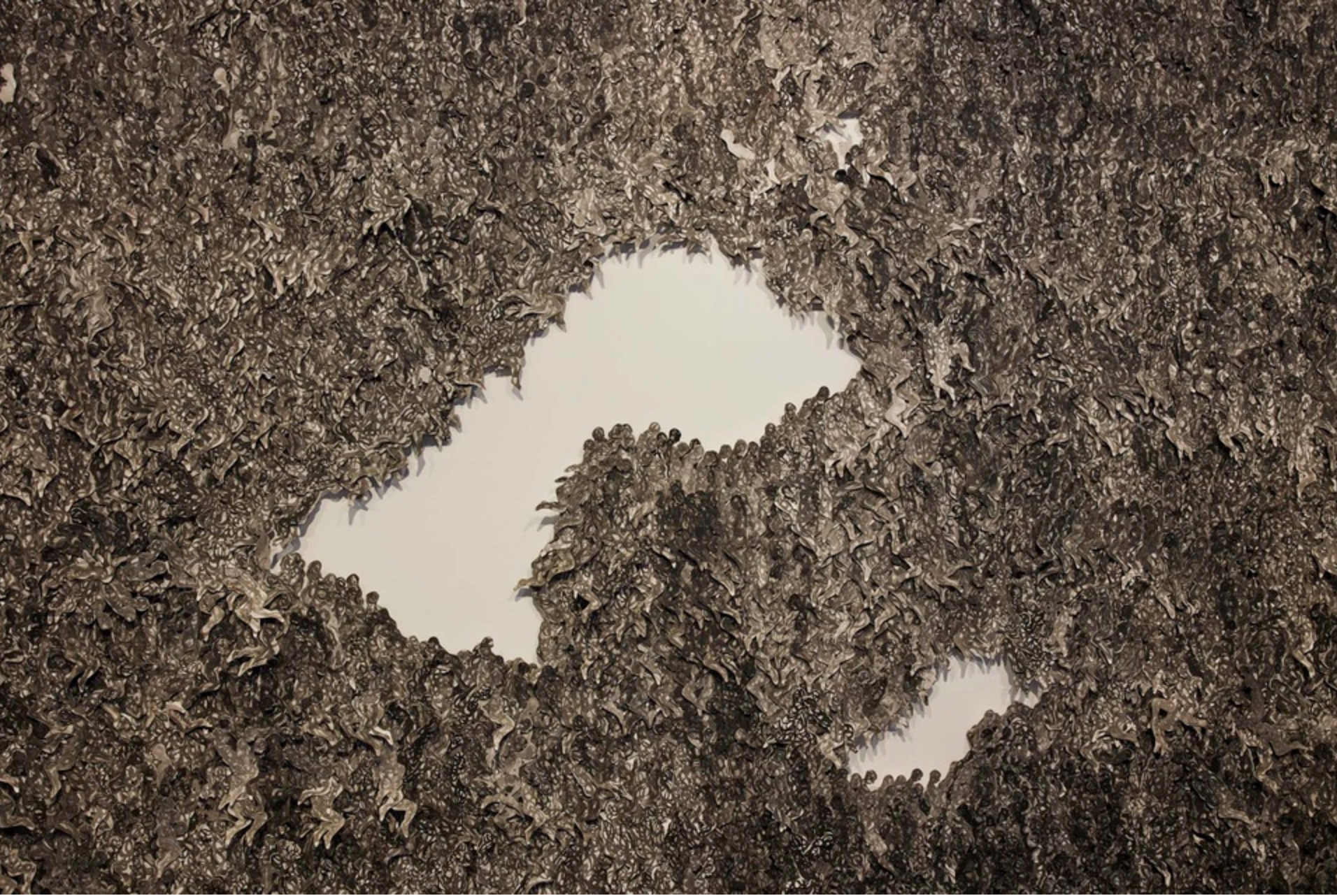
THE SUN IS bright and hard, the ferries and buildings glinting silver the day I catch the train to Sydney’s Circular Quay. I’m here to see Mehwish Iqbal’s work at the Museum of Contemporary Art Australia as part of The National biennial showcase of contemporary Australian art. For weeks I’ve been trawling Iqbal’s back catalogue online, hovering my cursor above works that explore mothers, migration and community. Finally, I am here. It’s the second day of winter, still a couple of weeks before the delta strain will spread from Sydney’s east (where I am) to the west, where I grew up and where Iqbal now lives. A couple of weeks before its separations will infuse our conversations with a particular distance.
To fully appreciate the scale of Grey Wall (2020–21), her imposing floor-to-ceiling installation, I have to step backwards until I am almost up against the artwork opposite. It is twenty metres long, roughly the size of a pygmy blue whale. Its black-and-white amorphous mass of human silhouettes is a commentary on global movement and migration. The figures overlap and swell, the work emerging like a landmass from the sea.
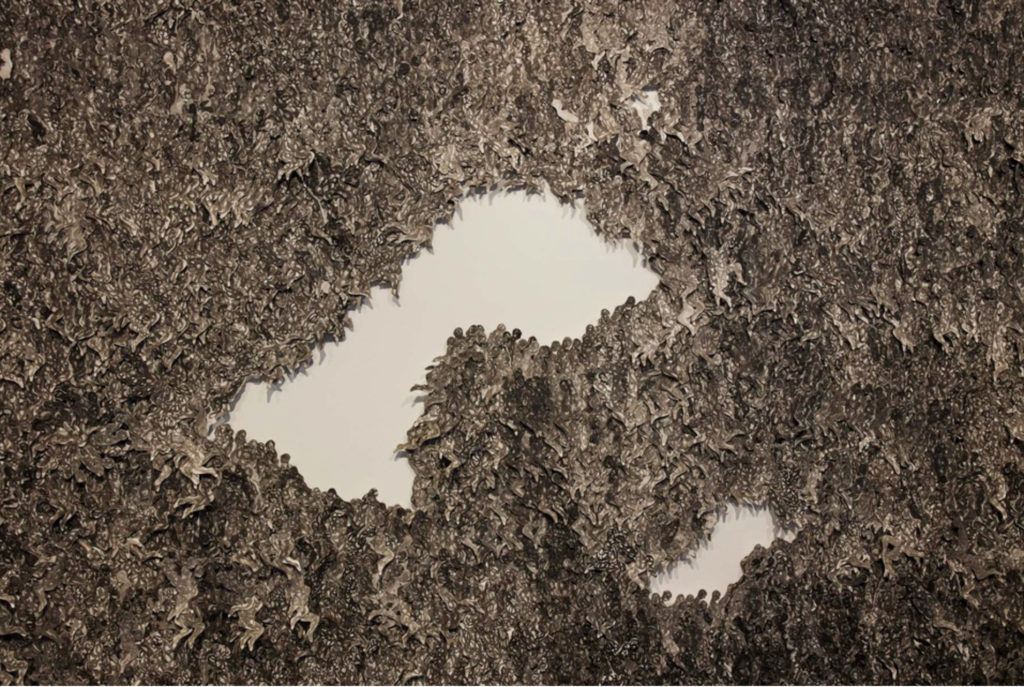
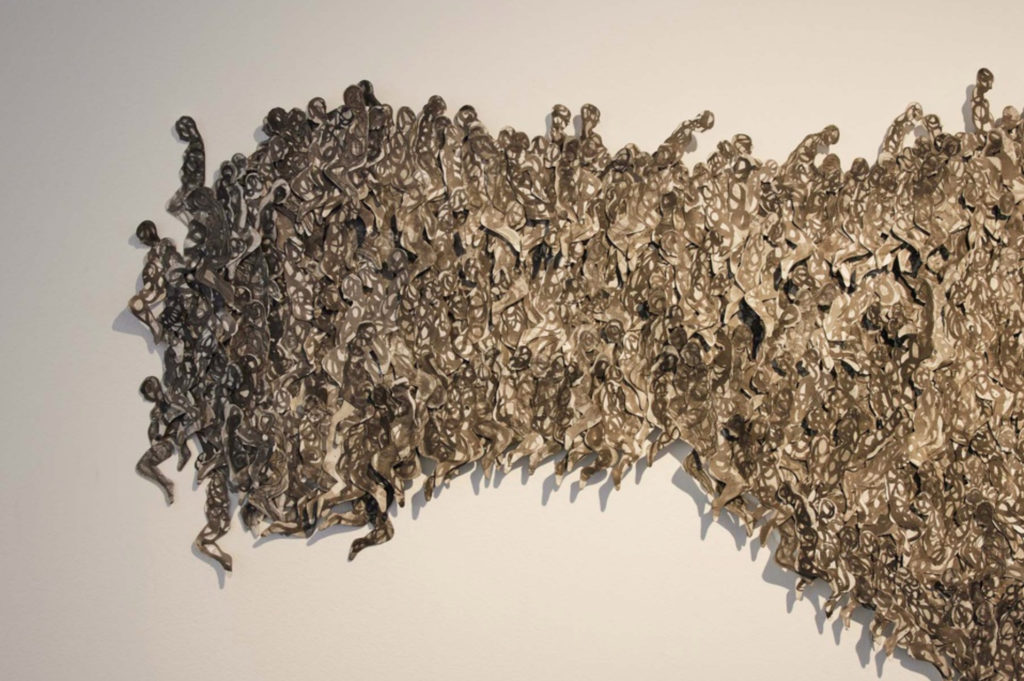 Mehwish Iqbal, Grey Wall (2020–21)
Mehwish Iqbal, Grey Wall (2020–21)
Born and raised in Sangla Hill in the Punjab region of Pakistan, Iqbal moved to Australia in 2006 to complete her postgraduate studies in printmaking at the University of New South Wales. Incorporating painting, textiles, sculpture and installation, her work explores refugee movements, diaspora, power, womanhood and identity. She has shown widely across Australia, Pakistan, the US, Turkey and Hong Kong, participating in international art fairs and exhibitions, including Contemporary Istanbul, Art Central Hong Kong, Karachi Print Biennial and Sydney Contemporary. While her work has been exhibited around the world, her subject matter often intersects with restrictions on human agency and movement.
This newest work comprises 50,000 paper silhouettes, each hand-cut and individually painted. It gives a sense of drifts of people surging forward and outward – heads, arms, legs protruding – in both orderly and chaotic migrations; absences or no-go zones are represented by white space. There is propulsion, movement, but also moments of stasis – a pause in the journey, a camp, a temporary settlement. Spillage across borders, too.
‘The work is referring to the global phenomenon of people being divided through policymaking, and the creation of boundaries which are heavily controlled,’ Iqbal says later when we speak on the phone.
The catalyst for the work was Donald Trump’s ascent to power in 2016 and his introduction of travel bans in 2017, barring individuals primarily from Muslim countries – later African ones – from entering the US. At the time, Iqbal was living in New York and researching the demarcation of territories in the aftermath of World War II, the ways in which families and communities were dislocated by these decisions. At the same time, protests outside her window were calling for an end to the enforced separation of Mexican families who had crossed the US border.
The three conversations that fed into this essay took place by phone as, like much of Australia and the world, we are kept apart by COVID-19. National borders are again tightened, families again separated and, through 2021, the Australian Government continues to pursue an inconsistent, often discriminatory, policy that bars people from certain countries entering Australia. My own parents made the difficult decision to fly to Russia at the start of the pandemic when my grandmother became critically ill. Stranded overseas as each consecutive Sydney-bound flight was cancelled, they were still lucky; many Australian citizens, far from home, have not had the chance to care for, or say goodbye to, loved ones.
We lose sight of individuals first in the largeness and messiness of global catastrophes and conflicts and then again in the tiny newspaper print that reports on them; individuals are often reduced to statistics. Haiti earthquake 2021: more than 2,200 dead. War in Afghanistan: more than 71,000 civilian fatalities. Australian immigration detention: 1,440 people held. It is sometimes hard to comprehend that these conflicts, calamities and policies affect individual people – until an image or a story hits you in the gut. Think of Alan Kurdi, the three-year-old Syrian refugee who drowned and washed up on the shore of the Mediterranean, along with his brother and mother, when their small inflatable boat capsized in September 2015. The image of one toddler lying face down in the sand made global headlines.
‘The reason each individual is painted with their own landscape is again emphasising the fact that each person is important in their own right,’ Iqbal explains of Grey Wall.
I watch video of her dipping the paper silhouettes into trays of grey wash, her face open and serene as her hands make each movement. Each of the 50,000 figures are then individually marked with paint to delineate their features. ‘I’ve lost count of the number of hours it took,’ she tells me. To me, those curves or lines seem as if they might signify a bad knee, a recent heartbreak, a smattering of freckles on the bridge of a nose, the agonising wait for a visa, shrapnel lodged in skin.
Waking early each morning, Iqbal worked until ten or eleven o’clock at night, six days a week. ‘The process weighed heavily on me… I was having conversations with that work every day and it took a toll.’
Her artwork demands that the viewer spend time with it, too. Absorbing, thinking, feeling. It’s necessary to move closer to examine clusters and individual figures, noticing both patterns and anomalies. There are areas of saturation – overlapping bodies, crowds, bottlenecks, and areas of sparseness – absence, stillness, danger. In the serene, climate-controlled space of a gallery, the viewer is invited into notions of exclusion and dislocation.
As for the shape the work took, refugees may live in borderlands for several years, Iqbal says, before ultimately being relocated. ‘But while there,’ she explains, ‘they develop a sense of community and they form their own boundaries, their own mappings, their own structures. So those formations are very organic.’ While looking at the installation, I’ve jotted down in my notebook: bark, moss (?) – my sense of the landscape of the work as I studied it. ‘If you look closely, there are some clusters that almost mimic the shapes of flowers, or the map of a country.’
As COVID-19 changes how we demarcate both the world and the people in it, Grey Wall is also a reflection on the way in which global and national laws and policies determine who can go where and whose lives we value. More broadly, for Iqbal, ‘the work is looking at the human condition and the notion of separation.’
A couple of weeks after I stand with this work in the gallery, the New South Wales Government will send in helicopters and the army to intimidate residents of western Sydney into compliance. In the state in which I live, it is easier to blame individuals, cheaper to deploy police, than to show good leadership and provide accessible financial support and vaccines.
But on the day of my visit, my world does not yet hold these moments. I catch the lift up to the rooftop bar and order a glass of wine. Shortly after, everything shifts.
I WAS HOPING to see Iqbal’s studio as I worked on this essay, to see her embroideries and sketches laid out on the table, perhaps beside a favourite mug (she tells me she drinks tea almost constantly), or flowers from her sunny garden. I imagine a large, solid dining table, a jumper tossed over a chair, a stuffed elephant left by her toddler on the rug; these tiny details that bring a person into focus endear us to each other.
‘How do you know when something is finished?’ I ask Iqbal.
‘Sometimes the work becomes very heavy in terms of its treatments, and it needs breathing space for the viewer to actually come close and study each element separately, and that’s when I think I need to step back a moment and remove myself from it.’
This is particularly the case, she explains, when she works with embroidery that involves multiple elements and layers – silver leaf, watercolour, thread. As she introduces a new component into a work, Iqbal observes how it converses with all the other components and makes adjustments until there is a sense of balance.
There are ‘certain times when you feel the work is not finished, not in its entirety, but you have to let go of it,’ she explains. That process can be a difficult one. ‘The work is personal, because it’s documenting something that is coming from you. So, you know, you get attached to a work, it’s of course hard to part with… But it’s like giving birth to a child and after you’ve given birth, you have to let go of that control.’ I can hear her newborn like a gull down the line. ‘But if I were in that space, I would never be able to make another work. I have to intentionally remove myself.’
I remember the panic when my first book went to print – it wasn’t ready, I wasn’t ready.
‘What’s the feeling you have when a work is complete?’ I ask
‘I never want to have it complete completely…’ She pauses. ‘Maybe after a month or so, I look at it and I’m like, this looks complete, maybe I made the right decision… It’s funny how the work actually speaks to you over time… After a year when I revisit it, maybe I think, no, I could have done more.’
That’s how I think about my own writing, too. The American writer George Saunders has described his own iterative and intuitive approach to editing – going over the same sentences, tweaking, adding here, removing there, until the work feels ‘right’. There are no fireworks in the sky, the heavens do not open; after a passage of time, the work might look different, too, and I feel impelled to again uncap my red pen.
In terms of the role of art in politics and activism, ‘art initiates dialogue,’ Iqbal says. ‘The idea is to bring light to certain things.’ She wants people to engage with the work, to spend time with it, to examine ideas and question norms through its lens. ‘When change occurs, or how change occurs, is not up to me.’
On the individual figures in Grey Wall, Iqbal reflects, ‘When you are in their presence, you can’t ignore this trend. And although they might be fragile singularly, when they are together, that fragility reverses itself and it becomes something very strong and powerful.’
ONE OF IQBAL’S earliest memories of making art is of sketching portraits of her grandmother’s cats and the neighbours and farmers who came by the house in Sangla Hill. Using raw charcoal left over from her mother’s cooking, she’d draw directly onto the floor or walls, as well as covering notebooks and her school slate in pictures.
‘Art is something that is part of me,’ she says, ‘so it’s not about making choices whether I wanted to be this or that… This is something that’s innate and has always been there…’
I’m fascinated by these kinds of statements: I have never had this certainty about my own art. While my peers read ‘proper’ books, I was sent to English as a Second Language classes to play with sock puppets and sound out words. I was not someone who grew up knowing they wanted to be a writer.
Iqbal’s grandmother, an important influence in her life, was raised without a formal education in Pakistan: Iqbal Begum taught herself to read and write, to farm and ride a tractor and, when her husband died, she raised their five young children on her own.
Iqbal relays this memory. One day, coming back from inspecting her land, Begum’s feet were bare and young Iqbal asked her grandmother, ‘Where are the shoes that your aunties gave you?’ The shoes were a new pair of expensive Italian slides.
It turned out that a stranger had said, quite casually, to Begum, ‘I will never have the chance to wear such beautiful shoes.’ Begum slipped off her slides, and both women stood, for a moment, barefoot in the fertile soil.
‘Nothing should be more important than people,’ as she later explained to her granddaughter.
‘Those are ideals that have been forged within me growing up as a child,’ Iqbal says. ‘You know, respect for every individual irrespective of where they’re coming from, what their beliefs are, or what their background or social status is.’
She grew up listening to her grandmother’s stories about Partition – the division of British India into two separate states, India and Pakistan, in 1947, which triggered violence and led to millions of people leaving their homes in search of safety. Her grandmother had firmly believed that individuals had a right to their own country and to freely practise their faith. Taking in both Muslim and Hindu refugees, she created makeshift camps, providing shelter and food for women and their families. ‘These events shaped my way of looking at life. So even what happens now, politically or geographically, I’m always sensitive to this,’ Iqbal says.
I think of Ann Patchett’s teacher, the writer and activist Grace Paley, who stuck ‘cancelled’ notices on classroom doors when there was something more pressing than writing good prose to attend to – a human rights protest, a rally, a cause. ‘She taught me that writing must not be compartmentalised,’ Patchett writes in her 2013 memoir This is the Story of a Happy Marriage. ‘You don’t step out of the stream of your life to do your work. Work was the life, and who you were as a mother, teacher, friend, citizen, activist and artist was all the same person.’
Even though Begum may not have shared her granddaughter’s passion for drawing, she understood its importance for her. ‘Don’t stop Iqbal from pursuing her dreams,’ she said to the family shortly before her death. With a lineage of engineers and doctors, Iqbal’s mother had hoped she would study dentistry or medicine like her sister.
I think of my own parents – both engineers; of their disquiet when I announced I was withdrawing from my commerce degree and then later from a bachelor of law to complete a double major in sociology and psychology. They had scrimped and saved roubles, then dollars, and here I was throwing away what they saw as a lucrative career to study the humanities. Like many migrants, they wanted for their kids the financial security and stability they themselves had once lacked.
Having spent most of her life apart from her mother, Iqbal explores the distance and separation that exists in Letters to My Mother (2017), a series of hand-carved raw charcoal sculptures with inscriptions in Urdu and English, a work that also pays homage to her mother’s cooking. During annual celebrations, the times when her mother came home to Sangla Hill each year, Iqbal would watch her tend to the charcoal stove, preparing dishes like saag, a spinach and cheese curry – Iqbal’s favourite – over low heat for days. She was showing her love for family through the art of cooking. Letters to My Mother is an attempt ‘to rekindle the relationship’, Iqbal writes of the work.
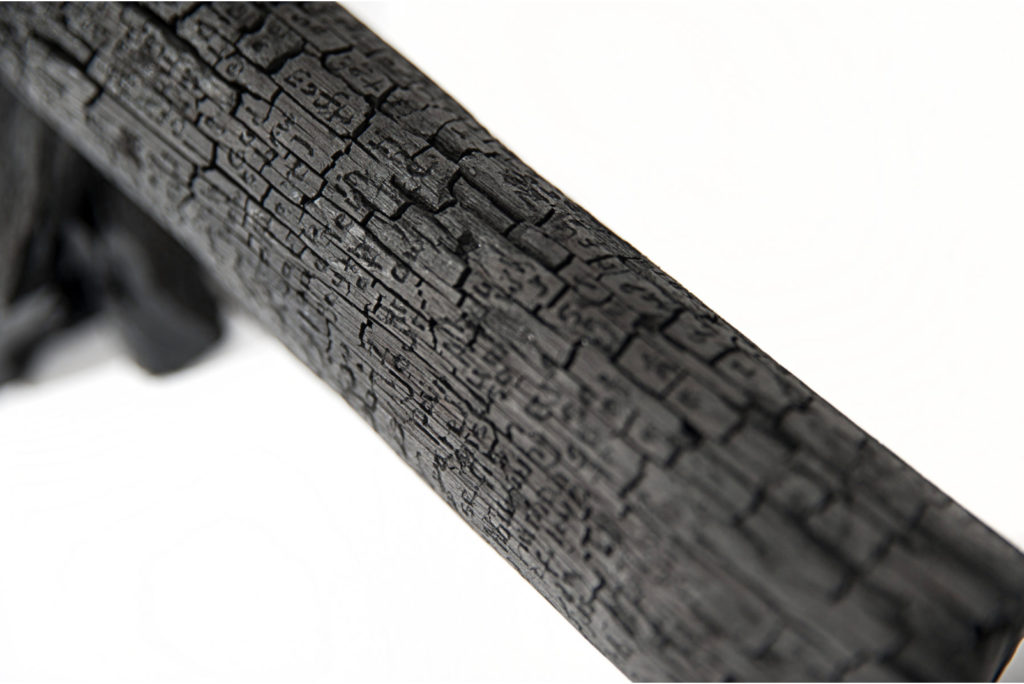
Mehwish Iqbal, Letters to My Mother (2017)
I understand the potential gulfs between mothers and daughters, especially as amplified by the migratory experience. In the same way that the English inscriptions on the charcoal are abstract to Iqbal’s mother, my writing in English is partly inaccessible to my mother, who speaks and reads almost exclusively in Russian. My mother still reads all my work, though it sometimes takes her a couple of goes, and she collects the publications and lines them up neatly on a shelf in my old room. As I look at the intimacy of Iqbal’s Letters to My Mother, it seems to magnify and personalise the disconnection and distance that might be experienced by any two silhouettes in Grey Wall.
Before her death, Begum visited the village and sat for a portrait as a favour to her granddaughter. During the hours of the sitting, Iqbal – sixteen at the time – tried to capture her grandmother’s mood, history and likeness, all the while keeping up a lively conversation. Even though Begum was in good health, Iqbal understood that this would be the last time the two women would see each other: it was an overpowering, ineffable sensation. Begum died shortly after, aged seventy-two. ‘I haven’t looked at the portrait since that day,’ Iqbal says. In fact, she gave up portraiture for many years until art school forced a reckoning and she was able to pick up her materials again. That portrait, she thinks, is still at her mother’s house.

Mehwish Iqbal, Fragments of an Assembled Landscape (2020)
STANDING WITH FRAGMENTS of an Assembled Landscape (2020), Iqbal’s other installation at The National, my attention is caught by the image of a crouching red woman on the far-left panel. She looks over her shoulder at me. Pregnant, heroic, defiant, her body is close to the earth and turned away in a protective gesture: body as shield. Iqbal was pregnant with her third child when she conceived this bright, intricate embroidery. It was when she became a parent for the first time, she says, that she started ‘looking back and trying to understand my own relationship with my mother. That became sacred within my art practice.’
Incorporating silk screen, drawing and hand embroidery, this work uses semi-translucent dressmaker’s paper as its base, different cut and sew marks visible like ghosts. It reminds me of a body labelled for surgery with permanent marker, of sutures, of a diagram of prime beef cuts. The inside close to the surface, visible, now outside.
‘I was always looking for materials that mimic the fragility and complexity of life,’ Iqbal says. A dressmaker’s paper catalogues the whole process of a garment’s creation, retaining traces of every stitch, every misstep, in the same way that our skin freckles, wrinkles, sags, stretches and scars as we age and go about our lives, recording the transformations and experiences of our existence on ourselves. Iqbal is interested in testing the limits of materials, in seeing how much they (and we) can bear.
In the far-right panel of the embroidery, a ferocious blue wolf provides the visual counterweight to the woman. An alpha male on patrol, he is keeping his pack in line, intruders out. Gold fangs bared, ready to tear meat from bone. Not so different, Iqbal says, from what goes on in human communities. While the pregnant woman symbolises care and nurture, the alpha wolf polices territories and protects the pack from external threats. There is no reason, Iqbal says, for those roles to be divided along gender lines.
Between these two figures stretches a vibrant pageant of celestial, animal and plant life. Human beings, but also winged creatures – in crimson, cerulean, gold, verdant green. Are they bearing messages, or perhaps simply watching over the menagerie of life?
‘When I was growing up with my grandmother, she used to tell mythical stories of angels and heavenly creatures…their meaning changes from work to work.’ They could be a reference to individuals who paved the way during Partition, she says. ‘In other contexts, they could be creatures taking inspiration from religious scriptures.’
In the context of the winged creatures in this work, Iqbal talks about the co-existence of different religions in societies, and also the inevitable fractures that exist. In 2014, she visited the Hagia Sophia Grand Mosque in Istanbul and was struck by the layering of history within this cathedral-turned-mosque, the jostling between Christian and Islamic elements. Calligraphy, medallions and minarets sit alongside mosaics depicting Jesus, Mary, archangels, seraphs and cherubs, some plastered over during the Ottoman Empire but since recovered and restored to create a complex stratigraphy that illuminates the past.
The longer I spend with Fragments of an Assembled Landscape, the more parallels I notice between the human and animal kingdom; the way we structure our communities, work together, occupy space, fight and keep the peace. ‘We had lots of animals at home,’ Iqbal tells me. ‘My grandmother had cats, my father had hens, my mother had goats.’ And as she says this, I can almost ‘hear’ her embroidery’s soundscape: insects buzzing in summer, the flap of wings, human voices, leaves rustling in the wind, a clarion call. There are bees, butterflies, pigeons, goats. White, translucent moths. Red marching lines of ants. Big-bellied beetles. So much bounty.
‘My grandmother had a beautiful garden, where all sorts of fruit trees were growing,’ Iqbal tells me, ‘and she used to take me and my sister every day to visit.’ While the girls climbed the trees, Begum planted seeds and tended to her garden. ‘I understood from a very young age that nature had an impact on your mood, because when we came back from visiting the garden, we were happy.’
From where she’s sitting, Iqbal tells me, she can see leafy trees, candy-coloured petunias, lavender, gardenias. Her house and studio in western Sydney were designed by her architect husband, and feature glass-fronted walls that blur the distinction between inside and outside. Having access to the garden is important for her practice, she says. In The Poetics of Space, Gaston Bachelard suggests that the maternal home, the house we were born in, becomes inscribed in our body, making all the future homes we inhabit attempts to recreate the very first. Perhaps it is true.
As for me, I do not remember the towering block of identical flats or snow-covered streets of Moscow where I was born. But I do remember the first house my parents bought in Australia – an apricot-coloured two-storey in Marayong, about an hour’s drive from where Iqbal now lives. We had nine eucalypts in the backyard, an army of furry orange-and-black caterpillars one summer.
Growing up, Iqbal and her family visited the eponymous monolith of Sangla Hill in the centre of town, and that landscape feature loomed large in her childhood imagination. The abrupt conical rock is striking in an otherwise flat, mostly green plain. ‘I think this is something within my blood, this love for land and love for nature,’ she says. Since the initial outbreaks of COVID-19, almost two years ago now, Iqbal has not been back to visit. As we talk, Sydney is partway through what will be five months of lockdown. When I ask how Iqbal is managing under some of the nation’s most coercive restrictions, she assures me that, through it all, she has kept making art.
I remember Elaine Scarry’s notion that each artefact we create (each painting, each meal, each book) is a ‘fragment of world alteration’. When Iqbal’s mother picks flowers and herbs in the field to make saag, when she tends to the simmering curry on the stove, when she ladles it into bowls, she is bringing into existence ideas of care, love and radical hospitality and sharing these with those at the table.
As for what I perceive as the fragility of her chosen materials, Iqbal is firm: ‘There’s nothing that is permanent. You look at all the artworks that were created over time, all the materials are supposed to disintegrate… An artwork has its own life.’
The thought is both terrifying and liberating.

Share article
About the author
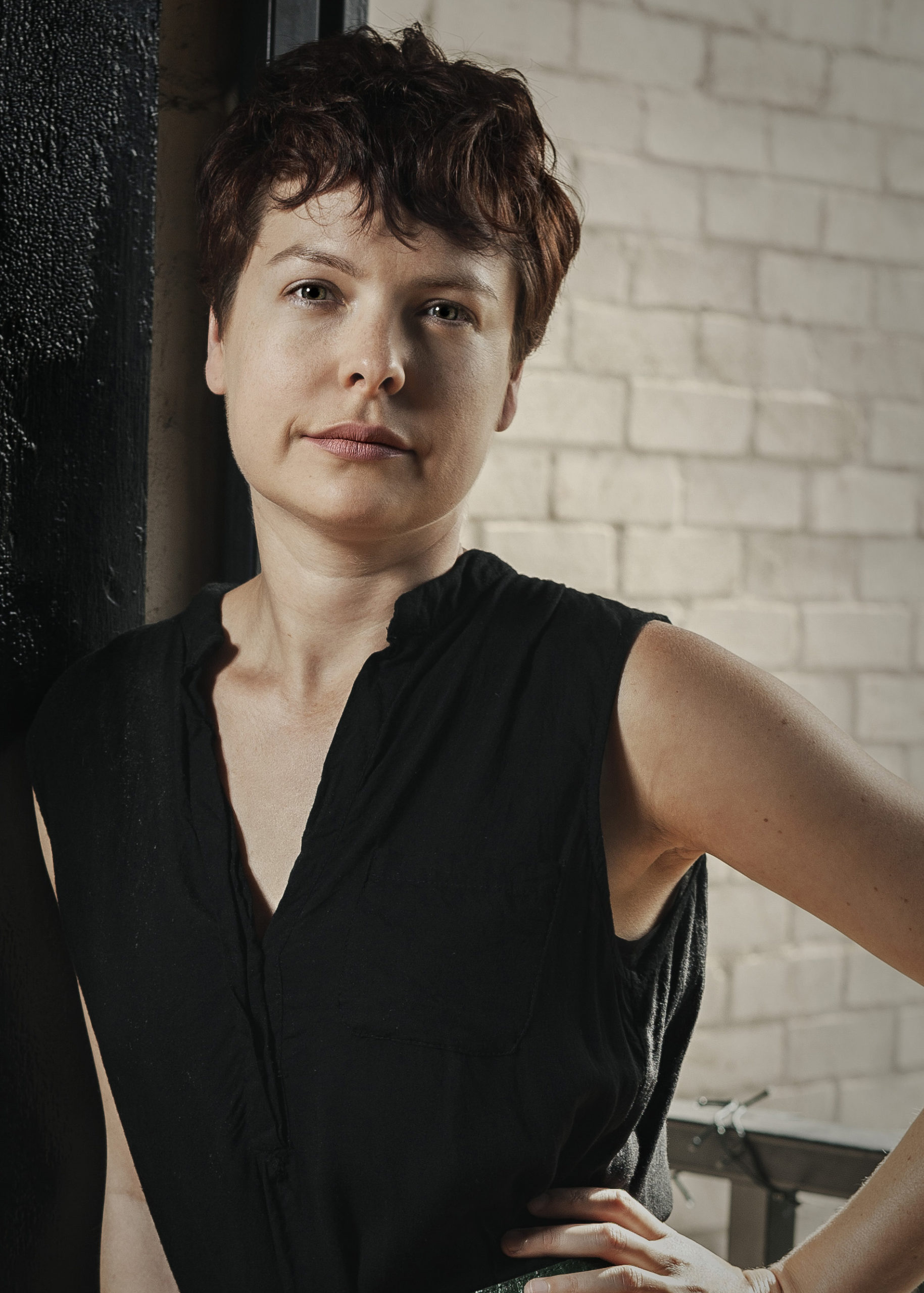
Tanya Vavilova
Tanya Vavilova is the joint winner of the 2021 Small Press Network Book of the Year Prize for her debut collection of essays We...